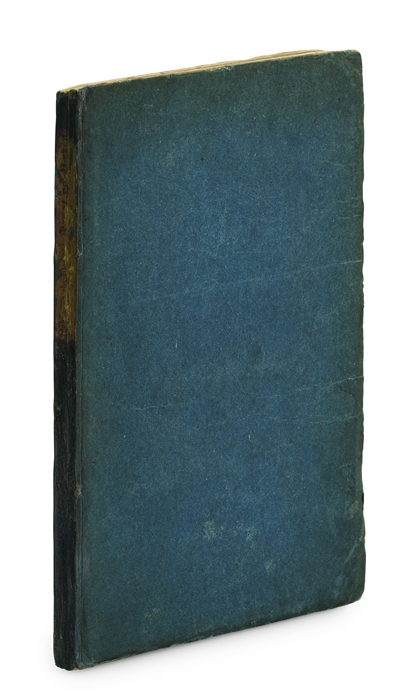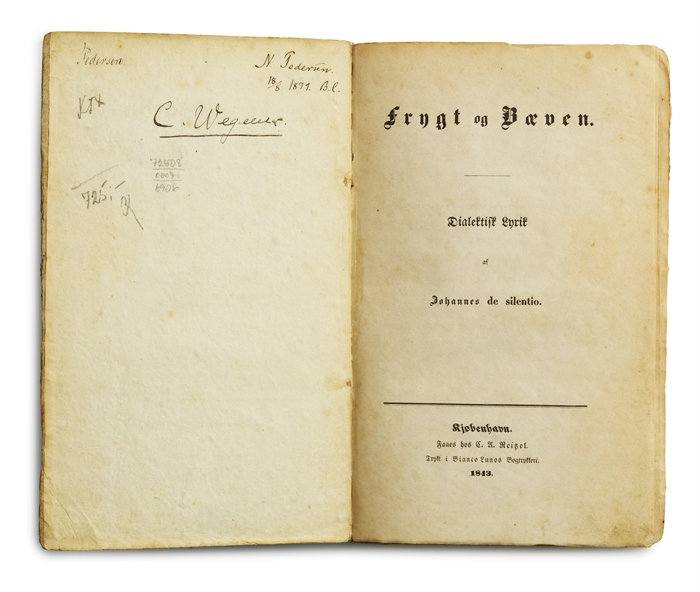A SPLENDID COPY IN THE ORIGINAL BINDING
KIERKEGAARD, SØREN.
Frygt og Bæven. Dialektisk Lyrik af Johannes de Silentio.
Kjøbenhavn, Reitzel, 1843.
8vo. VIII, 135 pp. Completely uncut in the original blue cardboard binding. Spine and front hinge neatly restored, preserving part of the original printed title-label. Brownspotting as usual. Overall a very nice copy indeed.
Old owners’ names to inside of front board (N. Pedersen 18/8 1879 and C. Wegener).
A splendid copy of one of Kierkegaard's most splendid and most sought-after works in the original binding, which is extremely rare. The spines of the original Kierkegaard cardboard bindings are always just thin paper directly glued on the block, making them extremely fragile, and the original paper-labels are hardly every preserved. Although Fear and Trembling is evidently printed in the same number of copies as almost all the other works by Kierkegaard (i.e. ca 525), this is one of the most difficult of his works to find in the first edition. Perhaps later research will show whether unsold copies were destroyed, which seems unlikely, however. We know that in July or August 1847, 321 copies of Fear and Trembling had been sold. What we also know is that it is highly sought-after by collectors and much less frequently on the market than most of Kierkegaard’s other works. It is very odd that not a single copy on special paper or in a gift-binding, presentation-copy or anything like that has been located or registered. For this title, a Kierkegaard-collector will have to make do with a “normal” copy. The present copy, in the original binding, and completely uncut, is the best copy we have come across over the last many decades. FEAR AND TREMBLING is one of Kierkegaard’s most important works. And it is also one of his most difficult. It deals – in forceful brevity – with the relationship between reason and faith and provides us with Kierkegaard’s most thorough exposition of the religious stage, which he considered the most meaningful form of existence. Setting the scene in his Preface with the punchy opening lines: “Not merely in the realm of commerce but in the world of ideas as well our age is organizing a regular clearance sale. Everything is to be had at such a bargain that it is questionable whether in the end there is anybody who will want to bid.”(Preface, Walter Lowrie’s translation, 1941), Kierkegaard begins the work with a rendering of the biblical tale of Abraham and Isak from the Old Testament, using it to illustrate how religious reasons can triumph over ethical. It is here that Kierkegaard introduces the “tragic hero” and contrasts it to the “Knight of Faith”, who both ignore their own wishes for a higher good. These two essential figures epitomize the ethical and the religious and pave the way for the understanding of these stages in Kierkegaard’s philosophy. It is arguably also here that the idea of the essential leap of faith is introduced for the first time. The Knight of Faith sacrifices his son at the command of God and thus sets aside an ethical demand in in order to attain a higher goal that exists beyond the ethical. This teleological suspension of the ethical requires a leap of faith that is only possible through faith in virtue of the absurd. In many ways, Fear and Trembling is the most forceful of Kierkegaard’s works, as is also indicated by the title. Kierkegaard himself also considered it one of his most significant productions and wrote in his posthumously published Notebooks: “Oh, once I am dead, Fear and Trembling alone will be enough for an imperishable name as an author. Then it will be read, translated into foreign languages as well. The reader will almost shrink from the frightful pathos in the book.” (NB 12:147, 1849). This splendidly dense work which so magnificently weaves together existential concerns with biblical interpretation is responsible for the introduction of many of the concepts that are most fundamental to Kierkegaard’s philosophy and is essential to the understanding of his thought. Not a single presentation-copy of the work is known to exist and none has ever been registered nor identified. We know from the auction catalogue that Kierkegaard had two copies in his collection, one in “dainty binding”, but neither copy has been located. Himmelstrup 48 The present copy is no. 18 in Girsel's "Kierkegaard" (The Catalogue) which can be found here.
Order-nr.: 62137


